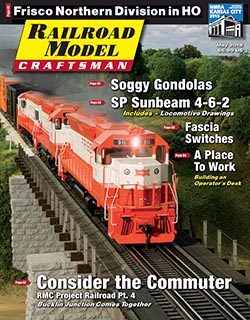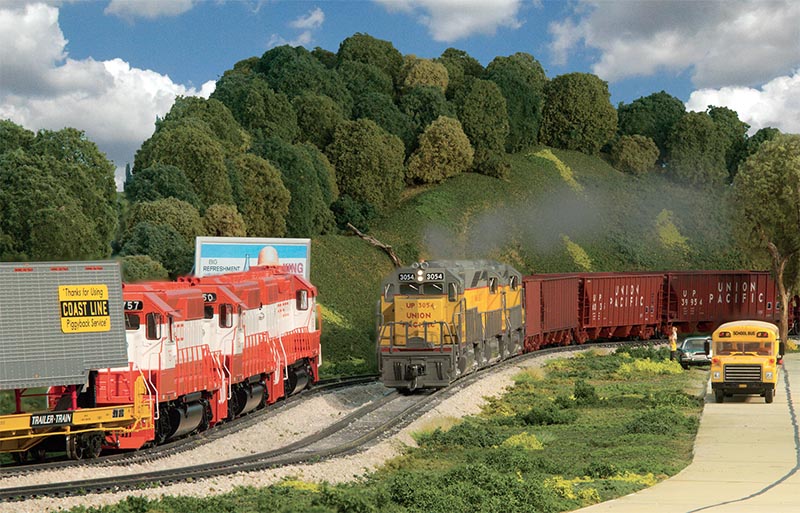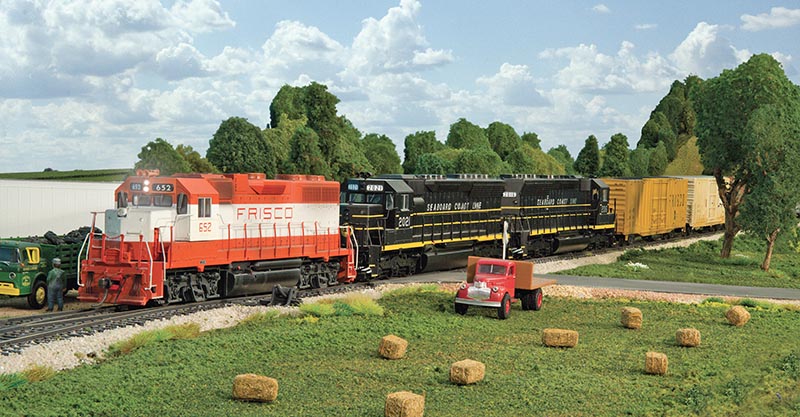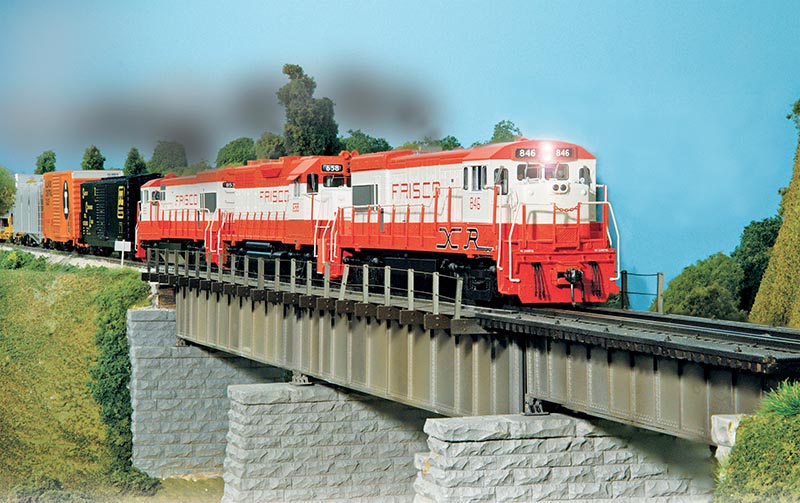 By Rick McClellan/photos by Dan Munson
By Rick McClellan/photos by Dan Munson
I had a great childhood, growing up in Springfield, Missouri, with many fond memories of the Saint Louis-San Francisco (SLSF or “Frisco”) Railway. Visits to my grandmother’s house on North West Ave. often included an unauthorized trip down to Division Street where I would watch black diesels moving cars back and forth at the Springfield Yard. Fast-forward a few years to a visit to my aunt’s house to see my cousin on leave from the U.S. Army. His footlocker full of Tyco trains became a temporary layout running from the kitchen, down the hall, and into the living room. Tyco boxes became tunnels and buildings as we ran trains all afternoon. My cousin gets all the credit for turning me into a train guy.
My lawn mowing and gardening jobs didn’t pay enough to buy a train set, but I made enough to buy a few train magazines. Each was devoured cover-to-cover as I dreamed about a layout. In high school, I started my first layout with a $15 Tyco Santa Fe set. Part-time work, school, and girls took most of my time, so the 4×6 layout on top of the family freezer really didn’t get past the “loop of track” stage.
While in college, I worked at a local Springfield lumberyard and helped a customer and his son buy a sheet of plywood for a train layout. The youngster had a custom-painted Frisco boxcar that caught my eye. All model trains I had seen were Santa Fe, Pennsylvania, or New York Central; no Frisco. They sent me to a local hobby store where I found a small assortment of custompainted Frisco cars, cabooses, and locomotives. Despite part-time wages and college expenses, I managed to buy an Athearn SW9 in Frisco orange and white. Soon, I was building a small 4×8-foot layout from lumberyard scraps in a spare bedroom of my small home. I quickly learned how to paint, detail, and letter models. My first project was an Athearn GP7 in orange and white using canned aerosol propellant and a Badger airbrush.

A southbound Frisco extra holds at Lenexa while northbound empty Union Pacific coal train RHKC (Rush Island, Mo. – Kansas City) continues north to UP’s Armstrong Yard in Kansas City, Kan. Both trains are running on the wrong side of the main as the Frisco dispatcher in Springfield clears up some congestion during a warm spring day in 1980.
After college graduation and a move to Kansas City to a new job, I read model railroad magazines and painted Frisco models that were pretty rough by today’s standards. I met Ron White at a train meet, and he introduced me to the wonderful world of operations. In my first session, Ron assigned me to switch the Pearl Brewery, which took me two hours to complete. It was probably a 20-minute job but using a model locomotive to move and spot cars had an enormous impact on me. Running trains on loops of track with no purpose would never do again. We had a lot of fun on his Frisco railroad and used the Keller On-Board command control system. Unfortunately, I could not stop the engine where I wanted with the keypad.
My first real layout was the Frisco from Springfield west to Aurora, Missouri. It was in a 900-square-foot basement and used the Keeler CTC-80 command control system. My friends and I learned a lot about operations, and had hours of fun running it. Then my wife decided the basement was too small, and I needed a larger one. Yes, you heard me right. My wife wanted me to have a larger basement. Be very careful when your wife starts talking like this because her solution will always be very expensive. I told her if she found a house with a huge basement with the utilities in the middle of the room, we could move. It took her only a week to find one. We moved into the new house in September 2000, and the new basement enabled the expansion of my former Springfield-based layout all the way to Kansas City. Oh, and my wife got a bigger, newer house that sat on top of the basement. Wow, what a coincidence. She will not get the same offer again.
It Had to Be Frisco
Like most modelers, I am often asked why I chose the Frisco. The biggest reason is that it’s a great trip back to a simpler time and place. No matter where my family went in Springfield, there was the Frisco, so I associate those great family times with the railroad.

Looks like the first cutting of the hay crop has been completed and the local teenage boys can make some money hauling it to barns in Spring Hill, Kan. The crew of northbound pool Train NWF enjoys the smell of fresh-cut hay and gives a hearty wave to farmers and city kids alike. Our consist today has a special treat with two Seaboard Coast Line SD45s behind Frisco GP38AC no. 652.
Another reason I chose the Frisco is that it was just a neat railroad. No other railroad, in my eyes, could match classic paint schemes like the orange and white diesels, the racehorse Eunits, gold leaf trim on the Mountain steam engines, and the iconic coonskin logo. I may have left Springfield, but I didn’t leave the Frisco, even after the Burlington Northern merger.
Layout Overview
My HO layout represents the Frisco Northern Division from Kansas City, Mo., south through eastern Kansas and into Springfield. The layout is currently set in 1980 just prior to the BN merger in November…
 Read the rest of this article in the May 2018 issue of Railroad Model Craftsman!
Read the rest of this article in the May 2018 issue of Railroad Model Craftsman!



